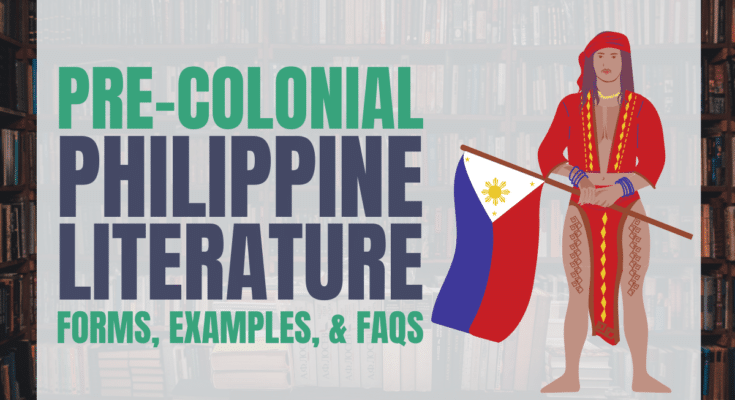The Philippines has a long history of storytelling, even before the Spanish arrived. These stories, passed down by word of mouth for many generations, were more than just entertainment. They were a way for our ancestors to teach people things, share important values, and connect with their culture. This blog will answer the question: “What are the dominant literary forms of pre-colonial Philippines?”
We’ll discuss each form of Philippine literature during pre-colonial period. We’ll also include pre-colonial literature examples and a brief explanation supporting each.
Forms of Philippine Literature During Pre-Colonial Period
Proverbs
Proverbs, known in Filipino as salawikain, are like practical advice passed down through generations. They often use rhymes to make them easier to remember and teach essential skills for navigating daily life.
Some examples include:
| Proverb (Salawikain) | English Translation | Meaning |
|---|---|---|
| “Ang hindi marunong lumingon sa pinanggalingan, hindi makakarating sa paroroonan.” | He who does not look back from where he came from cannot reach his destination. | This proverb emphasizes the importance of learning from the past. |
| “Ang palay ay hindi sa ibabaw ng bato namumunga.” | The rice does not bear fruit on top of a stone. | This proverb suggests that success requires the right conditions and hard work, not just luck. |
| “Yang ataog aw madugdug, di da mamauli.” | An egg, once broken, will never be the same again. | This Mandaya proverb about virginity emphasizes that some things cannot be undone once lost. |
| “In lasa iban uba, di hikatapuk.” | Love and cough cannot be hidden. | This Tausug proverb suggests that certain things, like secret affairs, are difficult to conceal. |
| “Lahat ng gubat ay may ahas.” | In every forest, there is a snake. | This proverb cautions that there are untrustworthy people everywhere one goes. |
Riddles
Riddles, or bugtong in Filpino, are mind teasers that challenge wit and creativity. Often poetic and playful, they use descriptions or metaphors to lead the listener to the answer.
During the pre-colonial period in the Philippines, riddles were a common form of oral literature. They are like proverbs but differ in one thing—they demand an answer.
Filipino riddles often have a humorous tone, but their answers are often more serious than expected.
Here are examples of Philippine riddles:
| Riddles (Bugtong) | Answer |
|---|---|
| Balong malalim, puno ng patalim (A deep well full of knives) | Bibig (Mouth) |
| Maliit pa si nene, marunong nang manahi (Nene is still a child but she already knows how to weave) | Gagamba (Spider) |
| Itinapon mo na, bumabalik pa (Even if you throw it away, it still comes back) | Yoyo |
| Hindi hari, hindi pari ngunit suot niya’y sari-sari (Not a king nor a priest but wears assorted wardrobe) | Sampayan (Clothesline) |
| Bumili ako ng alipin, mataas pa sa akin (I bought a slave that is higher than me) | Sumbrero (Cap) |
| Baboy sa lasang, ang tunok puro lansang (A wild pig of the forest, Is covered with spikes) – Bisaya riddle | Nangka (Jackfruit) |
| Sominub lawiyan, Mbowat lawitan. (It dived, It rose.) – Maranao riddle | Ragum (Needle) |
| Tagia que tagia, Hende ta penetra. (You keep on slashing it, But it does not penetrate.) | Agua (Water) |
Folksongs
Filipinos expressed their emotions and experiences through songs. These beautiful songs capture the joys and sorrows of our ancestors’ lives, from finding love to saying goodbye, and everything in between.
Here are five examples of Philippine folk songs during the pre-colonial period:
- Ili-ili (Ilongo): A lullaby that is an example of folk song in the Philippines during the pre-colonial period.
- Panawagon and Balitao (Ilongo): These are examples of love songs that were sung during the pre-colonial period.
- Bayok (Maranao): This is a type of folk song that originated from the Maranao people, a Muslim ethnic group in the Philippines, and is still sung today.
- Ambahan (Mangyan): This is a seven-syllable per-line (heptasyllabic) poem about human relationships, social entertainment, and a tool for teaching the young. It is an example of the traditional music of the Mangyans, an indigenous group in the Philippines.
Tales
These were narratives passed down, often explaining natural phenomena or cultural practices. These narratives also tell stories of origin. Often, they’re called myths and legends.
Here’s how they differ:
| Myths | Legends |
|---|---|
| Focus on the origin of things: Myths typically explain the creation of the universe, natural phenomena, or humanity itself. They provide a framework for understanding the world and humanity’s place within it. Often involve deities or supernatural beings: Creation myths feature powerful gods or goddesses who shape the world through actions. These myths can offer insights into the values and beliefs of the people who created them. | Grounded in a (somewhat) believable reality: Legends are more rooted in the real world and often feature explanations for landmarks, historical events, or cultural practices. They may involve real people or places, but often with fantastical embellishments. Can explain origins of customs or traditions: Legends might explain how a mountain came to be, why a particular group performs a specific ritual, or how a hero’s actions shaped a community. Blur the lines between fact and fiction: The line between truth and embellishment in legends can be blurry. While they may contain historical elements, they are not always considered entirely factual. |
| Examples: The Tagalog creation myth of Malakas and Maganda, who emerged from a split bamboo, or the Ifugao creation story, in which the first humans, Wigan and Bugan, hatched from an egg laid by a sky god. | Example: The legend of Maria Makiling, the beautiful guardian spirit of Mount Makiling. |
Epics
These are the crown jewels of pre-colonial literature. These lengthy narrative poems recount the adventures and misadventures of heroes and supernatural beings.
Here are a few examples:
| Epic | Description |
|---|---|
| Biag ni Lam-Ang | This is an epic from the Ilocos region (known to be the first Philippine folk epic to be recorded in written form) that tells the story of the heroic exploits of the mythical hero Lam-Ang. It recounts his supernatural birth, his quest for vengeance against his father’s killers, and many adventures and battles. The epic is known for its vivid imagery and poetic language. |
| Ibalon | The Ibalon epic originates from the Bicol region and narrates the legendary history of the Bicolano people. It describes the world’s creation, the arrival of the first settlers, and the exploits of heroic figures who fought against supernatural beings and established the foundations of Bicolano culture. |
| Hudhud and Alim | Hudhud and Alim are epic chants from the Ifugao people in the Philippines. Hudhud tells the story of Aliguyan, a powerful hero, and Bugan, alongside the creation of the world and the rise of their civilization. Alim focuses on their god Makanungan, other deities, and their concept of heaven. |
| Darangen | Darangen is the epic of the Maranao people of Mindanao. It is an extensive narrative (stories are told in 17 parts, with 72,000 lines) that chronicles the origins of the Maranao sultanate, the exploits of legendary heroes, and the struggles between warring kingdoms. The epic is renowned for its intricate poetic structure and its central role in Maranao culture and identity. One important story inside the epic is about a famous hero, Bantugan. |
Frequently Asked Questions about the Pre-colonial Philippine Literature
What is the pre-colonial era in the Philippines?
The Philippines’ pre-colonial era is like the Philippines before history books were written down. It’s a long time ago, way before the Spanish came in the 16th century. Imagine a Philippines made up of many independent communities with their own languages, customs, and traditions.
What is Philippine literature during the pre-colonial period?
Since there weren’t any printing presses yet, literature back then wasn’t like the books we read today. Instead, stories were passed down from generation to generation by word of mouth. Our ancestors would tell folktales, sing songs, recite poems, and chant proverbs to keep their traditions alive.
What is the difference between pre-colonial and colonial literature?
The main difference is when they were created. Colonial literature refers to stories written during the Spanish era, often influenced by European themes and religion. Literature written beyond this period, including American and Japanese, is also considered colonial literature. Pre-colonial literature, on the other hand, reflects the beliefs, way of life, and heroes of Filipinos before the arrival of the colonizers.
Why is pre-colonial literature important in the Philippines?
Pre-colonial literature is super important because it tells us much about how people lived back then. It shows their values, beliefs, and even how they saw the world around them. It’s like a window to the past!
What are the characteristics of pre-colonial literature in the Philippines?
Since it was passed down orally, pre-colonial stories often use repetition, rhyming, and vivid language to make them easier to remember and sing. They also focus on themes like bravery, community, and respect for nature.
How can these pre-colonial forms of literature be of use to your life right now?
Precolonial literature is like a treasure chest for understanding our past. These stories, myths, and poems are like windows into how people lived, what they believed in, and what was important to them way before colonization. This can help us appreciate our roots and where our traditions might come from. Plus, the lessons and morals in these stories are timeless. It’s like getting advice from old, wise people.
Do you think you can still use the lessons they teach in your daily life?
Yes! Even though things are different now, the lessons in precolonial literature can still totally apply today. They teach us about bravery, honesty, respect, and dealing with tough choices. These values are important no matter what time period you’re in. So, next time you read a pre-colonial story, think about the lesson it might be trying to tell. It might surprise you how relevant it can be!
If you’re looking for more resources about literature, then make sure to browse my website.




